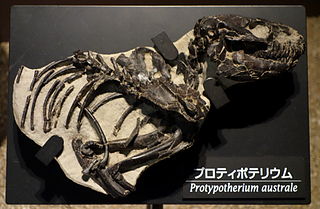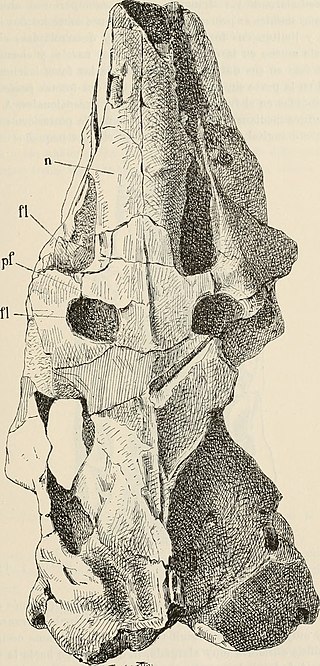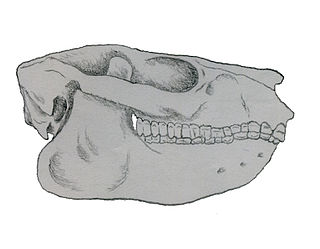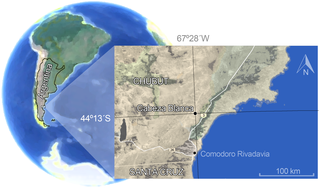
Protypotherium is an extinct genus of notoungulate mammals native to South America during the Oligocene and Miocene epochs. A number of closely related animals date back further, to the Eocene. Fossils of Protypotherium have been found in the Deseadan Fray Bentos Formation of Uruguay, Muyu Huasi and Nazareno Formations of Bolivia, Cura-Mallín and Río Frías Formations of Chile, and Santa Cruz, Salicas, Ituzaingó, Aisol, Cerro Azul, Cerro Bandera, Cerro Boleadoras, Chichinales, Sarmiento and Collón Curá Formations of Argentina.

Mesotheriidae is an extinct family of notoungulate mammals known from the Oligocene through the Pleistocene of South America. Mesotheriids were small to medium-sized herbivorous mammals adapted for digging.

The Cerro Azul Formation, in the Buenos Aires Province also described as Epecuén Formation, is a geological formation of Late Miocene age in the Colorado Basin of the Buenos Aires and La Pampa Provinces in northeastern Argentina.
Typotheriopsis is an extinct genus of Notoungulate, belonging to the family Mesotheriidae, which included several small sized Meridiungulates specialized in digging. It is considered as the sister taxon of the clade including Mesotherium and Pseudotypotherium. Its fossils are known from the Chasicoan and the Huayquerian periods, notably among Late Miocene rocks from the Arroyo Chasicó Formation and the Cerro Azul Formation of Argentina.

Paedotherium is an extinct, potentially paraphyletic genus of Notoungulate, belonging to the family Hegetotheriidae, composed of small-sized, rodent or lagomorph-like South American ungulates. Four species are unambiguously recognized, from the Late Miocene to the Pleistocene of Argentina, and from the late Miocene of Bolivia and Chile.

Prosotherium is an extinct genus of hegetotheriid notoungulate. It lived during the Late Oligocene, and its fossilized remains were found in South America.
Medistylus is an extinct genus of pachyrukhine hegetotheriid. It lived in Argentina during the Late Oligocene. Medistylus is known from its upper teeth and isolated skulls, however, its lower dentition is currently unknown. Its fossilized remains were found at the Cabeza Blanca and Las Cascadas localities of the Sarmiento Formation in Chubut Province of Argentina.
Ethegotherium is an extinct genus of Notoungulates, belonging to the suborder Typotheria. It lived from the Lower to the Middle Miocene, and its fossilized remains were discovered in South America. It might be a synonym of the genus Prohegetotherium.
Eohyrax is an extinct genus of Notoungulate, belonging to the suborder Typotheria. It lived during the Middle Eocene, and its remains were discovered in South America.

Hemihegetotherium is an extinct genus of hegetotheriid notoungulate that lived from the Middle to the Late Miocene of what is now Argentina.
Propachyrucos is an extinct genus of hegetotheriid notoungulate. It lived from the Late Oligocene to the Early Miocene, in what is today South America.

Pseudotypotherium is an extinct genus of Notoungulates, belonging to the suborder Typotheria. It lived from the Late Miocene to the Late Pliocene, and its fossilized remains were discovered in South America.

Plesiotypotherium is an extinct genus of Notoungulate, belonging to the suborder Typotheria. It lived from the Middle to the Late Miocene, and its fossilized remains were discovered in South America.
Archaeopithecus is an extinct genus of Notoungulate, belonging to the suborder Typotheria. It lived during the Middle Eocene, in what is today Argentina.
Oldfieldthomasia is an extinct genus of Notoungulate, probably related to the suborder Typotheria. It lived during the Middle Eocene, in what is today South America.
Argyrohyrax is an extinct genus of interatheriid notoungulate that lived during the Late Oligocene, of what is now Argentina and Bolivia.

Cochilius is an extinct genus of interatheriid notoungulate that lived between the Late Oligocene and the lower Miocene in what is now Argentina.

Notopithecus is an extinct genus of Notoungulate, belonging to the suborder Typotheria. It lived from the Middle to the Late Eocene and its fossilized remains were discovered in South America.
Hegetotheriopsis is an extinct genus of hegetotheriid notoungulate. It lived from the Late Oligocene to the Early Miocene, and its fossilized remains are found in Argentina.

The Sarmiento Formation, in older literature described as the Casamayor Formation, is a geological formation in Chubut Province, Argentina, in central Patagonia, which spans around 30 million years from the mid-Eocene to the early Miocene. It predominantly consists of pyroclastic deposits, which were deposited in a semi-arid environment. It is divided up into a number of members. The diverse fauna of the Sarmiento Formation, including a variety of birds, crocodilians, turtles and snakes, also includes many mammals such as South American native ungulates as well as armadillos, and caviomorph rodents.





















